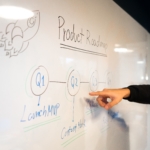One Lenovo: Creating a Cohesive Global Technology Solutions Company Begins with Unification
Lenovo Global Industry Analyst Conference (GIAC) 2023 was the first cross-business unit analyst event Lenovo has held since the start of the pandemic. The conference aimed to give analysts a view of the full breadth of Lenovo’s portfolio, the corporate identity weaving through the company’s various line-of-business (LOB) strategies, and the executives running the show from behind the scenes. Clear goals of the event were to drive market awareness of Lenovo’s capabilities, particularly around its Infrastructure Solutions Group (ISG) and Solutions and Services Group (SSG), and to contribute to the company’s multiyear efforts to reshape its brand image and be known as a wholistic technology solutions company.
Creating intersegment coherence with One Lenovo: CEO Yang Yuanqing
Among the challenges Lenovo has encountered as a global business, maintaining operational consistency while minimizing the increase in organizational complexity as the company scales is chief among them. As Lenovo grew beyond selling PCs with the acquisition of IBM’s (NYSE: IBM) x86 server business in 2016, the business units did not necessarily create broad synergies beyond operations optimization such as component sourcing and manufacturing. More specifically, the sales motion became and remains quite fragmented due to the differences in use cases and end-user personas of PC and server purchasers. To address this, Lenovo is undergoing a transformation to become a more cohesive company instead of a siloed one. This transformation effort has been dubbed “One Lenovo” and represents both an internal process and philosophy shift as well as an external interface shift to unify and simplify the company’s go-to-market approach for its customers and partners.
Lenovo CEO Yang Yuanqing’s background and affinity for hardware underpinned his sweeping message, which was a simple and respectably grounded one: Lenovo will continue to have the DNA of a hardware company. In spite of the changes in the company, including a long-term diversification of revenue, Lenovo will continue to sell a massive amount of hardware, and the portfolio changes regarding the company’s vision around solutions and services will be additive in nature, not alternative, to provide customers with end-to-end solutions in a diverse set of commercial scenarios.
Lenovo is bringing AI to the data: CTO & SVP Yong Rui
Predictably, another main focus of the event was to showcase Lenovo’s capabilities and strategy in AI across the portfolio. This began with Yong Rui, Lenovo’s CTO and SVP, laying out the context of Lenovo technologies in eight areas: cloud and edge computing, advanced computing, wireless technologies, vehicle computing, device innovation, next-gen interaction, the metaverse and AI. Rui clarified that Lenovo’s play in foundational models would not be in creating such models but rather leveraging them in its future vision of AI ownership and accessibility.
The company believes that three primary buckets of AI models will emerge: public models (foundational models) accessible to all, private models accessible to a group (such as enterprises), and personal models accessible to a single individual. On top of this, Lenovo suggests these models will differ in size, location (and underlying hardware), and personalization. In essence, Lenovo contends that it will be bringing AI to data rather than bringing the data to AI, as the company envisions a future where each device Lenovo sells will have AI embedded in it.
However, there is still a large gap in Lenovo’s current capabilities as well as the overall AI landscape that needs to be bridged in order to reach such a vision. For example, the multimodal framework will need interoperability for public, private and personal models to interact, which creates an underlying challenge in governance and data privacy protocols. Additionally, the battle between foundational AI models in the market remains ongoing, meaning no one truly knows which models will survive and continue to be developed, creating a challenge in future-proofing innovations.
AI initiatives
Lenovo’s AI strategy is currently a broad one. It starts with the company’s core competency in hardware to be an AI-capable infrastructure provider with its data center server portfolio, which includes NVIDIA GPUs. On top of that, Lenovo has an edge server portfolio that spans in form factor from the data center servers to clients featuring a variety of silicon options including Intel Atom, NVIDIA Jetson and AMD EPYC processors. To drive adoption of its edge servers, Lenovo has committed to invest $100 million into its AI Innovators program, which has begun introducing use-case-specific offerings with the goal of creating seamless, verticalized, outcome-based solutions deployments. In storage, Lenovo has been targeting the entry-level market while partnering with WEKA to enable workloads for high-performance compute (HPC) and AI through the combination of Lenovo’s software-defined storage platform and WEKA Data Platform software.
In Lenovo’s services division, SSG, AI activity is relatively nascent but is developing quickly. The company is building capabilities and solutions that leverage its operational and customer data to train foundational models. These initiatives are designed to improve both customer support and internal operational efficiency. Lenovo also previewed two new consumption-based TruScale offerings for AI — Developing AI at Scale as-a-Service and Applying AI at Scale as-a-Service — that were announced during the Lenovo Tech World event.
In its Intelligent Devices Group (IDG) Lenovo aims to compete in the AI PC space leveraging its core PC portfolio. Lenovo envisions a world where PC users will leverage AI to achieve hyperpersonalized experiences. The company hopes that the AI PC concept will accelerate refreshes in PCs to end the past year’s market slump.
In summary, Lenovo’s AI strategy spans all three business units with the most mature and tangible offerings coming out of ISG while SSG and IDG continue to develop. From an overall organizational standpoint, the company is in the middle of the first wave of AI portfolio expansion, defined by its broad pursuit of applications. Lenovo remains in the stage of discovering where AI is a sensible fit and where it may not be. What will follow is an eventual consolidation and clarification stage, where the company will delineate the disparate efforts from the successful vision-fit initiatives and drive a focused expansion from there. It will be exciting to see how the strategy unfolds.



